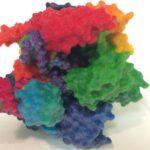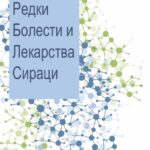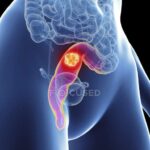 Castleman’s disease is a rare disease characterized by unicentric or multicentric enlargement of the lymph node, and it is mostly of the hyaline vascular type. Calcifying fibrous tumor is a neoplasm characterized by large areas of hyalinized collagen with paucicellular areas along with dystrophic calcification and scattered lymphoplasmacytic infiltrates. There are only five case reports to describe an association between these two entities. We report a case of a 38-year-old male with seropositivity for hepatitis B virus presenting with a right-sided cervical swelling. Fine-needle aspiration cytology (FNAC) was done, and a diagnosis of follicular hyperplasia was offered. Biopsy confirmed the diagnosis of Castleman’s disease. However, there was associated calcifying fibrous tumor in the lymph node induced by trauma due to FNAC. For more information click here.
Castleman’s disease is a rare disease characterized by unicentric or multicentric enlargement of the lymph node, and it is mostly of the hyaline vascular type. Calcifying fibrous tumor is a neoplasm characterized by large areas of hyalinized collagen with paucicellular areas along with dystrophic calcification and scattered lymphoplasmacytic infiltrates. There are only five case reports to describe an association between these two entities. We report a case of a 38-year-old male with seropositivity for hepatitis B virus presenting with a right-sided cervical swelling. Fine-needle aspiration cytology (FNAC) was done, and a diagnosis of follicular hyperplasia was offered. Biopsy confirmed the diagnosis of Castleman’s disease. However, there was associated calcifying fibrous tumor in the lymph node induced by trauma due to FNAC. For more information click here.
Publications
A very mild phenotype of Charcot-Marie-Tooth disease type 4H caused by two novel mutations in FGD4
 Mutations in the FGD4 gene cause an autosomal recessive demyelinating peripheral neuropathy referred to as CMT4H, characterized by its onset in infancy or early-childhood and its slow progression. The clinical and genetic status of two patients with CMT4H was studied, performing genetic testing with a panel of genes and analysing FGD4 mRNA expression by quantitative PCR. Two novel FGD4 variants (c.514delG and c.2211dupA) were identified in two mildly affected Spanish siblings with CMT4H, and with disease onset in late adolescence/adulthood (one of them remaining asymptomatic at 20). On examination, foot deformity was observed without weakness or sensory involvement, and in the muscles of the lower extremities magnetic resonance imaging showed no fat replacement. Further analysis of FGD4 expression in peripheral blood suggested that neither mutation affected splicing, nor did they affect the dosage of FGD4 mRNA (compared to a healthy control). It was predicted that each allele would produce a truncated protein, p.Ala172Glnfs*28 (c.514delG) and p.Ala738Serfs*5 (c.2211dupA), the latter containing all the functional domains of the native protein. The conservation of functional domains in the proteins produced from the FGD4 gene of two patients with CMT4H, could explain both the milder phenotype and the later disease onset in these patients. These results expand the clinical and mutational spectrum of FGD4-related peripheral neuropathies. For more information click here.
Mutations in the FGD4 gene cause an autosomal recessive demyelinating peripheral neuropathy referred to as CMT4H, characterized by its onset in infancy or early-childhood and its slow progression. The clinical and genetic status of two patients with CMT4H was studied, performing genetic testing with a panel of genes and analysing FGD4 mRNA expression by quantitative PCR. Two novel FGD4 variants (c.514delG and c.2211dupA) were identified in two mildly affected Spanish siblings with CMT4H, and with disease onset in late adolescence/adulthood (one of them remaining asymptomatic at 20). On examination, foot deformity was observed without weakness or sensory involvement, and in the muscles of the lower extremities magnetic resonance imaging showed no fat replacement. Further analysis of FGD4 expression in peripheral blood suggested that neither mutation affected splicing, nor did they affect the dosage of FGD4 mRNA (compared to a healthy control). It was predicted that each allele would produce a truncated protein, p.Ala172Glnfs*28 (c.514delG) and p.Ala738Serfs*5 (c.2211dupA), the latter containing all the functional domains of the native protein. The conservation of functional domains in the proteins produced from the FGD4 gene of two patients with CMT4H, could explain both the milder phenotype and the later disease onset in these patients. These results expand the clinical and mutational spectrum of FGD4-related peripheral neuropathies. For more information click here.
 MetabERN is one of the 24 European Reference Networks created according to the European Union directive 2011/24/EU on patient’s rights in cross border healthcare. MetabERN associates 69 centres in 18 countries, which provide care for patients with Hereditary Metabolic Diseases, and have the mission to reinforce research and provide training for health professionals in this field. MetabERN performed a survey in December 2017 with the aim to produce an overview documenting research activities and potentials within the network. As the centres are multidisciplinary, separated questionnaires were sent to the clinical, university and laboratory teams. Answers were received from 52 out of the 69 centres of the network, covering 16 countries. A descriptive analysis of the information collected is presented. The answers indicate a marked interest of the respondents for research, who expressed high motivation and commitment, and estimated that the conditions to do research in their institution were mostly satisfactory. They are active in research, which according to several indicators, is competitive and satisfies standards of excellence, as well as the education programs offered in the respondent’s universities. Taken as a whole, these results provide an encouraging picture of the research capacities and activities in the MetabERN network, which, with respect to the number and representativeness of the investigated centres, gives a comprehensive picture of research on Hereditary Metabolic Diseases in Europe, as well as the priorities for future actions. Marginal activity in human and social sciences points out the limited multidisciplinary constitution of the responding teams with possible consequences on their current capability to participate to patient’s empowerment programs and efficiently collaborate with patient’s advocacy groups. For more information click here.
MetabERN is one of the 24 European Reference Networks created according to the European Union directive 2011/24/EU on patient’s rights in cross border healthcare. MetabERN associates 69 centres in 18 countries, which provide care for patients with Hereditary Metabolic Diseases, and have the mission to reinforce research and provide training for health professionals in this field. MetabERN performed a survey in December 2017 with the aim to produce an overview documenting research activities and potentials within the network. As the centres are multidisciplinary, separated questionnaires were sent to the clinical, university and laboratory teams. Answers were received from 52 out of the 69 centres of the network, covering 16 countries. A descriptive analysis of the information collected is presented. The answers indicate a marked interest of the respondents for research, who expressed high motivation and commitment, and estimated that the conditions to do research in their institution were mostly satisfactory. They are active in research, which according to several indicators, is competitive and satisfies standards of excellence, as well as the education programs offered in the respondent’s universities. Taken as a whole, these results provide an encouraging picture of the research capacities and activities in the MetabERN network, which, with respect to the number and representativeness of the investigated centres, gives a comprehensive picture of research on Hereditary Metabolic Diseases in Europe, as well as the priorities for future actions. Marginal activity in human and social sciences points out the limited multidisciplinary constitution of the responding teams with possible consequences on their current capability to participate to patient’s empowerment programs and efficiently collaborate with patient’s advocacy groups. For more information click here.
 Rare diseases (RDs) affect a small percentage of the population but can be severely debilitating and life-threatening. Historically, patient groups (PGs) have been the prime movers in raising awareness about these diseases and advocating for national supportive policies. They have also driven relevant research programs. In India too, PGs have made significant contributions to the national RD ecosystem. The objective is to assess the contribution of various Indian RD PGs, we carried out an interview-based study of 19 organizations. This study aims to highlight the origins and achievements of these groups and the challenges that they have faced. Of the 19 PGs, two are umbrella organizations, two are other organizations of national scope and 15 are disease specific groups. 14 interviewees were affected by an RD either directly or through a family member. If reinstated, and properly implemented, this policy could significantly improve RD management in the country. PGs have had a significant role in bringing diagnostics and treatments to India. They have also raised awareness about RDs and related issues such as newborn screening, prenatal diagnostics and genetic counselling. This study highlighted the recommendations of various PGs. The government should address these recommendations and institutionalize the participation of the PGs in formal decision making. For more information click here.
Rare diseases (RDs) affect a small percentage of the population but can be severely debilitating and life-threatening. Historically, patient groups (PGs) have been the prime movers in raising awareness about these diseases and advocating for national supportive policies. They have also driven relevant research programs. In India too, PGs have made significant contributions to the national RD ecosystem. The objective is to assess the contribution of various Indian RD PGs, we carried out an interview-based study of 19 organizations. This study aims to highlight the origins and achievements of these groups and the challenges that they have faced. Of the 19 PGs, two are umbrella organizations, two are other organizations of national scope and 15 are disease specific groups. 14 interviewees were affected by an RD either directly or through a family member. If reinstated, and properly implemented, this policy could significantly improve RD management in the country. PGs have had a significant role in bringing diagnostics and treatments to India. They have also raised awareness about RDs and related issues such as newborn screening, prenatal diagnostics and genetic counselling. This study highlighted the recommendations of various PGs. The government should address these recommendations and institutionalize the participation of the PGs in formal decision making. For more information click here.
 Zynteglo is a medicine used to treat a blood disorder known as beta thalassaemia in patients 12 years and older who require regular blood transfusions. People with this genetic condition cannot make enough beta-globin, a component of haemoglobin, the protein in red blood cells that carries oxygen around the body. As a result, these patients have low red blood cell levels and need frequent blood transfusions. Zynteglo is used in patients who do not completely lack beta-globin and who are eligible for stem cell transplantation but do not have a matching related donor. Beta thalassaemia is rare, and Zynteglo was designated an ‘orphan medicine’ (a medicine used in rare diseases) on 24 January 2013. Zynteglo contains as its active substance stem cells taken from the patients that have been genetically modified to contain a working gene for beta-globin. For more information click here.
Zynteglo is a medicine used to treat a blood disorder known as beta thalassaemia in patients 12 years and older who require regular blood transfusions. People with this genetic condition cannot make enough beta-globin, a component of haemoglobin, the protein in red blood cells that carries oxygen around the body. As a result, these patients have low red blood cell levels and need frequent blood transfusions. Zynteglo is used in patients who do not completely lack beta-globin and who are eligible for stem cell transplantation but do not have a matching related donor. Beta thalassaemia is rare, and Zynteglo was designated an ‘orphan medicine’ (a medicine used in rare diseases) on 24 January 2013. Zynteglo contains as its active substance stem cells taken from the patients that have been genetically modified to contain a working gene for beta-globin. For more information click here.
 The mitochondrial medicine society (MMS) has previously highlighted the clinical landscape and physician practice patterns of mitochondrial medicine in the US and attempted to develop consensus criteria for diagnosis and management to improve patient coordinated care. Most recently, and in collaboration with US-based patient advocacy groups, we developed a clinical care network to formally unify US-based clinicians who provide medical care to individuals with mitochondrial disease; to define, design and implement best practices in mitochondrial medicine building on the current consensus guidelines and to improve patients’ clinical outcomes. Here we review the steps taken in collaboration with several stakeholders to develop goals and expectations for a mitochondrial care network (MCN), criteria for MCN site selection and formal launch of the network. For more information click here.
The mitochondrial medicine society (MMS) has previously highlighted the clinical landscape and physician practice patterns of mitochondrial medicine in the US and attempted to develop consensus criteria for diagnosis and management to improve patient coordinated care. Most recently, and in collaboration with US-based patient advocacy groups, we developed a clinical care network to formally unify US-based clinicians who provide medical care to individuals with mitochondrial disease; to define, design and implement best practices in mitochondrial medicine building on the current consensus guidelines and to improve patients’ clinical outcomes. Here we review the steps taken in collaboration with several stakeholders to develop goals and expectations for a mitochondrial care network (MCN), criteria for MCN site selection and formal launch of the network. For more information click here.
 Classic galactosemia is a rare inborn error of carbohydrate metabolism, caused by a severe deficiency of the enzyme galactose-1-phosphate uridylyltransferase (GALT). A galactose-restricted diet has proven to be very effective to treat the neonatal life-threatening manifestations and has been the cornerstone of treatment for this severe disease. However, burdensome complications occur despite a lifelong diet. For rare diseases, a patient disease specific registry is fundamental to monitor the lifespan pathology and to evaluate the safety and efficacy of potential therapies. In 2014, the international Galactosemias Network (GalNet) developed a web-based patient registry for this disease, the GalNet Registry. The aim was to delineate the natural history of classic galactosemia based on a large dataset of patients. Observational data derived from 15 countries and 32 centers including 509 patients were acquired between December 2014 and July 2018. Most affected patients experienced neonatal manifestations (79.8%) and despite following a diet developed brain impairments (85.0%), primary ovarian insufficiency (79.7%) and a diminished bone mineral density (26.5%). Newborn screening, age at onset of dietary treatment, strictness of the galactose-restricted diet, p.Gln188Arg mutation and GALT enzyme activity influenced the clinical picture. Detection by newborn screening and commencement of diet in the first week of life were associated with a more favorable outcome. A homozygous p.Gln188Arg mutation, GALT enzyme activity of ≤ 1% and strict galactose restriction were associated with a less favorable outcome. For more information click here.
Classic galactosemia is a rare inborn error of carbohydrate metabolism, caused by a severe deficiency of the enzyme galactose-1-phosphate uridylyltransferase (GALT). A galactose-restricted diet has proven to be very effective to treat the neonatal life-threatening manifestations and has been the cornerstone of treatment for this severe disease. However, burdensome complications occur despite a lifelong diet. For rare diseases, a patient disease specific registry is fundamental to monitor the lifespan pathology and to evaluate the safety and efficacy of potential therapies. In 2014, the international Galactosemias Network (GalNet) developed a web-based patient registry for this disease, the GalNet Registry. The aim was to delineate the natural history of classic galactosemia based on a large dataset of patients. Observational data derived from 15 countries and 32 centers including 509 patients were acquired between December 2014 and July 2018. Most affected patients experienced neonatal manifestations (79.8%) and despite following a diet developed brain impairments (85.0%), primary ovarian insufficiency (79.7%) and a diminished bone mineral density (26.5%). Newborn screening, age at onset of dietary treatment, strictness of the galactose-restricted diet, p.Gln188Arg mutation and GALT enzyme activity influenced the clinical picture. Detection by newborn screening and commencement of diet in the first week of life were associated with a more favorable outcome. A homozygous p.Gln188Arg mutation, GALT enzyme activity of ≤ 1% and strict galactose restriction were associated with a less favorable outcome. For more information click here.
 Acromegaly is a rare disease with vocal changes being a common clinical finding. The authors present a very rare case of an opera singer with undetected acromegaly for years, whose tessiture progressively changed from tenor, to baritone, to bass. We analyze the evolution of vocal parameters over the years and the outcome after surgical treatment. For more information click here.
Acromegaly is a rare disease with vocal changes being a common clinical finding. The authors present a very rare case of an opera singer with undetected acromegaly for years, whose tessiture progressively changed from tenor, to baritone, to bass. We analyze the evolution of vocal parameters over the years and the outcome after surgical treatment. For more information click here.
 X-linked hypophosphatemia (XLH) is a hereditary disorder characterized by increased renal phosphate wasting, which leads to clinical manifestations of rickets, bone deformities and growth retardation. XLN is transmitted as an X-linked dominant trait, affects both sexes equally and accounts for 80% of familial hypophosphatemic disorders. The disease is frequently manifested during the first two years of life. However, because of extremely variable severity and presentation, the diagnosis may be made late in adolescence and adulthood. Early diagnosis and adequate treatment of XLH is of paramount importance for achieving better disease management outcomes, such as fewer bone deformities, improved growth and better dental health. The study of XLH epidemiology is difficult because of low number of studies in this direction. In the recent years new molecular genetic tests have made possible the precise diagnosis and are now included in some of the studies with XLH patients. This publication aims to analyze the available epidemiological data on X-linked hypophosphatemia, as well as to provide an insight into XLH prevalence in Bulgaria. For more information click here.
X-linked hypophosphatemia (XLH) is a hereditary disorder characterized by increased renal phosphate wasting, which leads to clinical manifestations of rickets, bone deformities and growth retardation. XLN is transmitted as an X-linked dominant trait, affects both sexes equally and accounts for 80% of familial hypophosphatemic disorders. The disease is frequently manifested during the first two years of life. However, because of extremely variable severity and presentation, the diagnosis may be made late in adolescence and adulthood. Early diagnosis and adequate treatment of XLH is of paramount importance for achieving better disease management outcomes, such as fewer bone deformities, improved growth and better dental health. The study of XLH epidemiology is difficult because of low number of studies in this direction. In the recent years new molecular genetic tests have made possible the precise diagnosis and are now included in some of the studies with XLH patients. This publication aims to analyze the available epidemiological data on X-linked hypophosphatemia, as well as to provide an insight into XLH prevalence in Bulgaria. For more information click here.
Laparoscopic colorectal cancer resection in an elderly patient with factor XI deficiency
 Congenital XI factor deficiency is a rare disease caused by autosomal recessive inheritance. Clinically, there are few spontaneous hemorrhages, which can cause abnormal bleeding after trauma, surgery, and tooth extraction. We experienced a colon cancer patient with congenital XI factor deficiency who was successfully treated by laparoscopic approach with the administration of the preoperative fresh frozen plasma (FFP). The patient was an 82-year-old woman who complained of right lower abdominal pain for ap eriod of 2 months with no previous history of abnormal hemostasis. She received colonoscopy and was diagnosed with ascending colon cancer. Preoperative blood tests resulted in prolongation of activated partial thromboplastin time (APTT). After further investigation, factor XI (FXI) activity was found to be abnormal at 3.0% and congenital FXI deficiency was diagnosed. By replenishing FXI by FFP, APTT was improved to 37 s so perioperative abnormal bleeding could be avoided and an operation for ascending colon cancer performed. The patient received laparoscopic ileocolic resection and was discharged on a postoperative day 7 uneventfully. It is important to detect coagulation disorders such as FXI deficiency during routine preoperative checkups, and it is also important to consider unrecognized coagulation disorders if we encounter unexplained abnormal bleeding after surgery or trauma. In patients who have already been diagnosed with FXI deficiency, appropriate treatment including administration of FFP should be considered before surgery, and laparoscopic approach has a possibility to bring safety outcomes as an effect of the reduction of the intraoperative bleeding. For more information click here.
Congenital XI factor deficiency is a rare disease caused by autosomal recessive inheritance. Clinically, there are few spontaneous hemorrhages, which can cause abnormal bleeding after trauma, surgery, and tooth extraction. We experienced a colon cancer patient with congenital XI factor deficiency who was successfully treated by laparoscopic approach with the administration of the preoperative fresh frozen plasma (FFP). The patient was an 82-year-old woman who complained of right lower abdominal pain for ap eriod of 2 months with no previous history of abnormal hemostasis. She received colonoscopy and was diagnosed with ascending colon cancer. Preoperative blood tests resulted in prolongation of activated partial thromboplastin time (APTT). After further investigation, factor XI (FXI) activity was found to be abnormal at 3.0% and congenital FXI deficiency was diagnosed. By replenishing FXI by FFP, APTT was improved to 37 s so perioperative abnormal bleeding could be avoided and an operation for ascending colon cancer performed. The patient received laparoscopic ileocolic resection and was discharged on a postoperative day 7 uneventfully. It is important to detect coagulation disorders such as FXI deficiency during routine preoperative checkups, and it is also important to consider unrecognized coagulation disorders if we encounter unexplained abnormal bleeding after surgery or trauma. In patients who have already been diagnosed with FXI deficiency, appropriate treatment including administration of FFP should be considered before surgery, and laparoscopic approach has a possibility to bring safety outcomes as an effect of the reduction of the intraoperative bleeding. For more information click here.
